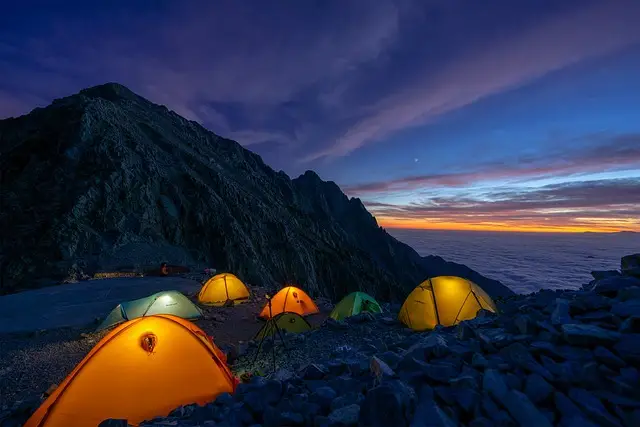For many first-time campers, staying warm at night can be a big concern. Cold nights can turn what should be a fun adventure into a shivering, uncomfortable experience. Whether you’re camping in the mountains, forest, or by a lake, temperatures can drop quickly at night—even in warmer seasons.
The good news is that with a few simple tips and some basic gear, you can stay toasty and comfortable through the night. In this blog, I’ll walk you through everything you need to know about staying warm while camping, so you can enjoy your trip without worrying about the cold.
Why Is Staying Warm at Night So Important?
Let’s face it, no one wants to spend their camping trip feeling cold. But beyond just comfort, staying warm at night is important for your overall health and well-being.
Being too cold can disrupt your sleep, leaving you groggy and tired for the next day’s activities. In more extreme conditions, being unprepared for the cold can even lead to hypothermia, a dangerous drop in body temperature.
Luckily, you don’t need to be an expert camper to keep yourself warm. With the right preparation and gear, you’ll be able to enjoy a cozy night under the stars no matter the temperature.
Step 1: Pick the Right Campsite

Before we even get into gear, let’s talk about something that can make a big difference in how warm you stay at night: where you set up your tent. Believe it or not, your campsite’s location can affect how cold you’ll feel once the sun goes down.
Avoid Low Areas or Valleys
Cold air tends to settle in lower areas like valleys, so if you camp at the bottom of a hill or in a dip, you might notice it’s a lot colder than the surrounding area.
Instead, try to set up your tent on higher ground or at least a flat spot. Even a small change in elevation can make a big difference in temperature.
Look for Natural Windbreaks
If it’s going to be windy, consider pitching your tent near natural windbreaks like trees, bushes, or rocks. The wind can really sap your body heat, so sheltering your tent from strong gusts will help you stay warmer through the night.
Pay Attention to the Sun
If possible, choose a spot that gets morning sunlight. It’s always nice to wake up to the warmth of the sun, especially after a cold night. This might not make a huge difference in how warm you stay during the night, but it’ll make getting out of your sleeping bag a lot more pleasant!
Step 2: Choose the Right Tent
Believe it or not, your tent plays a big role in keeping you warm. While tents don’t generate heat, they do act as a barrier between you and the elements—like wind, rain, and cold air. Here’s what you need to know about picking the right tent for staying warm.
Use a Tent That Matches the Season
Not all tents are created equal. Some are designed specifically for summer camping, while others are built for colder conditions.
If you’re camping in chilly or unpredictable weather, look for a three-season tent. These tents are designed to handle spring, summer, and fall conditions, providing more insulation and wind resistance than lightweight summer tents.
Make Sure Your Tent Is the Right Size
While it might seem like a bigger tent would be better, a tent that’s too large for the number of people inside can actually make you colder.
Why?
Because your body heat will spread out over a larger space. A smaller tent, on the other hand, keeps you closer together, which can help retain warmth. If you’re camping solo or with one other person, a two-person tent is ideal.
Step 3: Invest in a High-Quality Sleeping Bag

Check the temperature rating on your sleeping bag.
Your sleeping bag is your best friend when it comes to staying warm at night. But not all sleeping bags are created equal, and choosing the right one can make all the difference between a cozy night’s sleep and a freezing night of shivering.
Understand Sleeping Bag Temprature Ratings
Sleeping bags come with temperature ratings that indicate the lowest temperature at which the bag will keep you warm. For example, a sleeping bag rated for 20°F means it should keep you warm down to that temperature.
However, it’s a good idea to choose a bag with a rating that’s lower than the actual temperatures you expect to encounter. If you’re camping in 40°F weather, a sleeping bag rated for 20°F will give you a comfortable buffer in case the temperature drops lower than expected.
Choose the Right Type of Insulation
Sleeping bags come in two main types of insulation: down and synthetic. Both have their pros and cons:
Down: Lightweight and highly compressible, down sleeping bags offer excellent warmth. However, down loses its insulating ability when wet, so it’s not the best choice for rainy or damp environments unless your bag has a water-resistant shell.
Synthetic: Synthetic sleeping bags are bulkier than down, but they perform better in wet conditions because they maintain their insulation even when damp. They’re also generally less expensive.
If you’re a beginner camper, a synthetic sleeping bag with a temperature rating lower than the expected nighttime temperatures is a great option to start with.
Use a Sleeping Bag Liner for Extra Warmth
If you’re worried your sleeping bag won’t be warm enough, or you just want a little extra comfort, consider using a sleeping bag liner. These liners are lightweight and can add an extra 10–15°F of warmth to your sleeping bag. Plus, they’re easy to pack and wash, so they’re a great addition to your camping gear.
Step 4: Use a Good Sleeping Pad
A lot of beginner campers don’t realize that what’s underneath you is just as important as what’s on top when it comes to staying warm. The ground can be surprisingly cold, and without proper insulation, it will pull heat away from your body throughout the night.
Types of Sleeping Pads
There are three main types of sleeping pads: closed-cell foam pads, self-inflating pads, and air pads.
Closed-cell foam pads: These are lightweight, durable, and inexpensive. While they don’t offer the most comfort, they provide decent insulation between you and the cold ground.
Self-inflating pads: These pads are filled with foam that expands when the valve is opened. They offer a great combination of comfort and insulation and are easy to use.
Air pads: These are inflatable pads that provide excellent comfort and insulation. Many air pads are designed with built-in insulation to trap warmth. They pack down small but can be more expensive than foam pads.
Check the R-Value
When choosing a sleeping pad, look for the R-value. This measures the pad’s ability to insulate you from the cold ground. The higher the R-value, the better the insulation. For cooler weather camping, look for a sleeping pad with an R-value of 3 or higher.
How I Learned the Hard Way About Sleeping Pads
I used to think sleeping pads were just for comfort, so when I first started camping, I didn’t bother using one. I figured I could tough it out on the ground. Boy, was I wrong! The cold ground sucked the heat right out of me, and I spent most of the night shivering thinking about the pad I didn’t get. After that trip, I invested in a good sleeping pad, and it’s been a game-changer ever since. Now, I never camp without it!
Step 5: Dress for Success—Layer Up!
What you wear to bed can make a big difference in how warm you stay at night. Wearing the right layers can trap your body heat and keep you cozy, while wearing the wrong clothing can leave you shivering.
Wear Base Layers to Bed
Instead of bundling up in bulky clothes, wear a moisture-wicking base layer to bed. Base layers are designed to keep you warm while pulling moisture away from your skin.
This is important because if you sweat during the night, that moisture can cool you down and make you feel colder. Look for synthetic or wool base layers—they’re much better at keeping you warm than cotton.
Add Insulating Layers as Needed
If it’s really cold, you can add a mid-layer, like a fleece jacket, on top of your base layer. Just make sure your layers are breathable, so you don’t end up sweating too much.
Wear a Hat
You lose a lot of heat from your head, so wearing a beanie or wool hat to bed can help keep you warm. This is especially helpful if your sleeping bag doesn’t have a hood.
Keep Your Feet Warm
Cold feet can make it hard to stay warm, so don’t forget to wear clean, dry socks to bed. If your feet tend to get cold easily, you might even want to wear two pairs of socks or invest in some insulated camping socks.
Step 6: Eat and Drink to Stay Warm

Did you know that what you eat and drink before bed can affect how warm you feel at night? Your body burns calories to generate heat, so giving it the right fuel before bed can help keep you warm.
Eat a High-Calorie Snack
Before you hit the sack, eat a high-calorie snack like nuts, cheese, or chocolate. Your body will burn the calories as you sleep, helping to keep you warm.
Drink Something Warm
A cup of hot chocolate or tea before bed can also help warm you up from the inside. Just make sure you don’t drink too much—you don’t want to be running to the bathroom in the middle of the night!
Stay Hydrated
Dehydration can make you feel colder, so make sure you’re drinking enough water throughout the day. However, don’t drink too much water right before bed, or you’ll end up needing to go in the middle of the night.
Step 7: Prepare for Extra Cold Nights
Sometimes, despite your best efforts, the temperature drops lower than expected. In those cases, it’s good to have a few extra tricks up your sleeve.
Use a Hot Water Bottle
One of the oldest tricks in the book is to fill a water bottle with hot water and put it in your sleeping bag before bed. This acts like a mini heater, keeping your sleeping bag warm. Just make sure the bottle is securely closed so it doesn’t leak.
Cuddle Up (If You’re Not Solo!)
If you’re camping with a partner, sharing body heat is one of the easiest ways to stay warm. Zip your sleeping bags together, or simply cuddle up to share warmth. It’s nature’s heating system!
Conclusion: A Cozy Night Awaits
Staying warm while camping doesn’t have to be difficult. With the right gear, proper layering, and a few tricks, you can enjoy a comfortable, cozy night no matter how chilly it gets outside. Remember to prepare for colder temperatures than expected, choose the right campsite, and pack smartly. Your first camping experience should be filled with fun and adventure, not worrying about the cold. So get out there, stay warm, and enjoy the magic of a night under the stars!
Explore more. Fear less.
- Why Road Trips are One of the Best Ways to Clear Your Mind - November 21, 2024
- 10 of the Best Pumpkin Patches in the U.S. - October 23, 2024
- 10 of the Most Colorful Fall Road Trips in the U.S. - October 22, 2024
